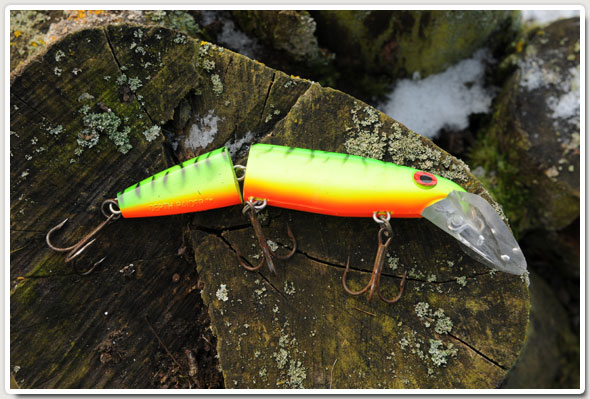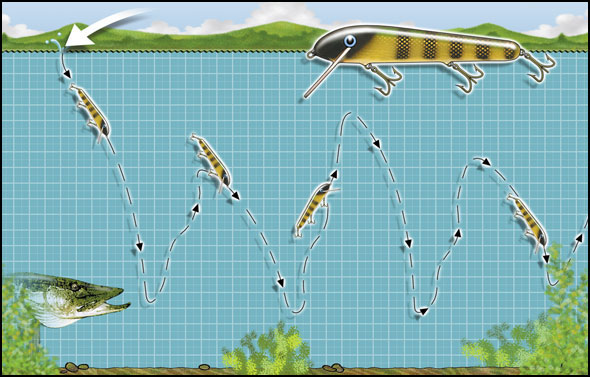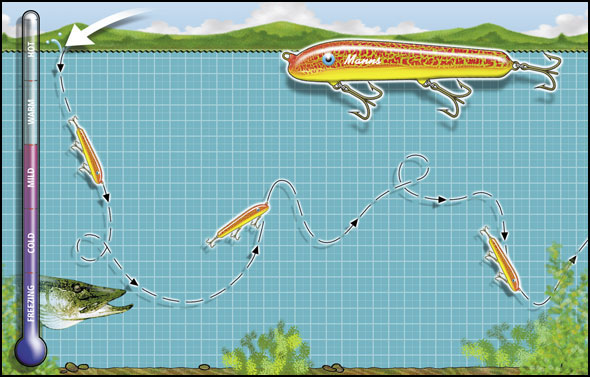Are you using the right fishing lure?
Spoons, plugs, spinners, jerkbaits, spinnerbaits, poppers, shads, jigs, micro jerks, floaters, divers, jointed, trolling – there are so many different pike and predator fishing lures out there that picking the right one to use is an absolute nightmare for the newcomer to lure fishing. Here we explain everything we know about lures and how they perform.
We won’t detail colours of lures in this article because that is something that varies on any given day and there isn’t a definitive ‘best colour’. If there was, all lures would be that one colour! Instead this in-depth article details what to look out for when buying lures to catch pike, zander, chub and perch.
In the main lures can be split into five different groups: plugs, spinners, jerkbaits, spinnerbaits and shads. And of those groups there are many variants. Take plugs for example – there are floating plugs, sinking plugs, jointed and diving plugs.
Here we’ll cover them all in detail to explain how they all work and perform, plus we’ll show you how to retrieve each style for the maximum effect.
Choosing plugs
Plugs can be bought in single bodied or jointed form. They perform the same but you'll find the jointed lures wriggle and can produce more fish.
You’ll find that most plugs have metal or plastic lips protruding from the heads. These lips are designed to either make floating plugs dive to a specific depth when they are wound back, or the lip will ensure that sinking plugs maintain their depth when they are cranked back or trolled behind a boat.
Some plugs to not have lips. These are floating plugs designed to catch fish in the surface layers because they do not dive under the surface very far – only inches in most cases. Great for summer pike action.
The angle of the lip will determine how deep floating lures dive. If the lure has a long lip that points straight out front it will dive very quickly indeed and will be designed for winding down to depth of around 10ft or even more. These are perfect in winter when the predators will be lying at the bottom.
If you see a floating lure that’s lip points downwards it will be a shallow diver – it will dive quickly to around 4ft deep maximum.
There are lips set at 45 degrees to the body – these will dive to around 6-8ft, so all depths can be covered by a variety of floating diving plugs that have different lip angles.
Sinking plugs will continue to drop to the bottom until you start retrieving. If these lures didn’t have lips they would simply come straight up to the surface, but the force of the water against the lip pushes the lure down. The combined effect of trying to wind the plug to the surface against the force of the water pushing down on the lip makes the lure travel in a straight line. It will only begin rising upwards when it nears the angler and the upward pull from the reeling beats the downward force on the plug’s lip.
The lips on plugs vary massively. The uppermost plug has a long, straight lip that will make it dive very quickly to extreme depths. The lower plug has a lip that protudes downwards and this will make the plug dive to only a few feet. A good combination of lip patterns will ensure that you can cover a multitude of depths.
With care, sinking plugs can be worked at any depth. All you have to do is to count them down. As soon as the lure hits the surface start counting and start the first retrieve when you reach two. On the next cast aim at the same spot, count to four, then start retrieving. If the water’s deep enough do the same again but count to six.
Doing this ensures that your plug works at different levels of the water, giving you a higher chance of retrieving your plug right alongside a pike.
Some plugs are jointed versions. They perform exactly the same as the above descriptions except they wriggle when they work through the water. They are very popular lures because of this added attraction.
Here's how floating plugs work underwater. When you crank the plug back it will dive to a depth determined by the angle of the lip, and when you stop winding the lure back it will begin to float upwards again. Simply repeat the process to create a zig-zag pattern through the water.
Benefits of spinners and spoons
These are very simple lures that can be used throughout the year. They are easy to fish with and easy to work through the water – all you do is wind the spinner in.
As they are made from metal they sink very quickly so you’ll have to count them down again from the instance they splash down to ensure that the spinners are working at the required depth, and once you’re happy that the lure has fallen to the right depth you must start retrieving steadily.
As soon as spinners start moving they will rotate and this creates a series of flashes as the shiny metal base and coloured top spins. It’s these flashes that attract the predators.
Fishing with jerkbaits
A decade ago jerkbaits were out of reach for most anglers as they required incredibly powerful and specialist rods that are only any good for jerkbait fishing, super strong traces of 100lb-plus breaking strain, 100lb braided mainlines and powerful multiplier reels. Now times have changed and thankfully any lure fisherman can use the new breed of micro jerkbaits on the market.
Years ago jerkbaits used to weigh between 6-12oz and cost £25 or so apiece. Now you can buy much smaller mini jerkbaits that weigh the same as most plugs and cost under a tenner – perfect!
Here's examples of jerkbaits. On the left, we have the new breed of micro-jerks and on the right are the original jerkbaits that can weigh in excess of 8oz.
These lures catch loads and loads of fish, and that’s a fact. The reason why is because these lures don’t travel back to the rod in a straight line or upon a straight plane – they dart sideways, up, down, they even sometimes turn right around and flip over. They really are amazing.
To make these lures perform as haphazardly as that requires a completely different technique. Instead of winding the lures back they should be flicked back using short and sharp flicks of the rod. The rod should be jerked downwards to make the lure shoot forwards, then the angler will have to lift the rod and wind in some line then jerk the rod down again.
The results can be amazing – we would definitely advise you give these tremendous little micro jerkbaits a try.
You will need to use a braided mainline though because mono will stretch and absorb some of the action made by flicking the rod tip down.
Here's how jerkbaits work underwater. Some jerkbaits sink while others float, but they should still be fished in the same manner, which involves flicking the rod tip downwards sharply to force the jerkbait through the water. This action will make the lure dart about all over the place.
Fishing through weed with spinnerbaits
Amazingly these V-shaped lures with their inward-pointing hooks do catch predators. They are quite specialised in that not many anglers use them, probably due to the strange shape and not knowing just how affective they can be.
But spinnerbaits are great fish catchers as – like a certain lager - they reach the parts other lures can’t. Because of the inward-pointing hook they can be worked really close and often through strands of weed – the lure just bounces through the green stuff. And in winter, when the pike sink to the bottom and tuck themselves up right in the strands of weed, these lures can be very effective indeed.
To fish them correctly requires using the countdown method (detailed above) to ensure that the lure works at the right depth. When it’s steadily wound back to the rod tip the lure spins and flashes as the metallic spoon attached to the body catches any light at the bottom of the water.
Here's how spinner baits perform underwater. They should be counted down to the bottom and then retrieved steadily with the odd pause to make them flutter through any weed on the bottom.
Bumping the bottom with shads
Borne from the sea angling world, shads have found a large following among coarse predator anglers. In fact, once an avid lure angler discovers just how lifelike and effective these simple rubber, wobbly baits are they find it difficult to switch back to the old-style of lures.
The vast majority of shads are based upon two pieces – a flexible rubber body and a weighted head that has a long but powerful single hook.
A typical selection of shads. You can clearly see the metallic, weighted heads, the large single hook protruding from the back and the colourful rubber bodies. As the hook remains uppermost, you can bounce these shads along the bottom, safe in the knowledge that they won't become lodged in weed.
Shads can be caught complete with the hook embedded within the body and the weighted head in place, or they can be bought separately which is a good thing because often the hook far outlasts the plastic body that can quickly become ripped to shreds by pike’s teeth.
When rigged-up correctly the hook should protrude out of the top of the plastic body so that the lure can come to rest on the bottom with the hook pointing upwards, well out of the way of any weed. This makes the lures perfect for bouncing along the bottom to create plenty of disturbance and even small clouds of silt eruptions from the lake or river bed that will attract the attention of nearby predators.
For this reason they are ideal in the depths of winter when the pike lay close to the bottom.
Splashing the surface with poppers
In summer and autumn, when the pike can sometimes be seen close to lilies and weeds, inches underneath the surface, you will do well fishing with poppers. These small lures are purpose-built to attract pike near the surface.
They are tubular lures that are extremely buoyant. They don't have lips to make them dive, but they might have flattened noses, concave noses or even propeller-type blades at the back. All those features are designed to create as much disturbance on the surface as possible.
The principle behind poppers is to make as much noise as possible. And to do this the lures should be cast out, the line should be straightened to the lure and then quick, short, sharp flicks of the rod tip will make the lure dart forward a couple of feet making a terrific splash as it moves. It's those splashes that will grab the pike's attention.
Braided mainlines work best with poppers as they have no stretch, so any movement on the rod will be transferred directly to the lure making it move even more violently than could ever be achieved if you use mono mainlines.
There are many different types of surface lure - some resemble frogs, some resemble water voles, while others resemble fish. they are definitely worth a try when pike fishing in the summer months as the takes can be explosive!
Here's how to fish a popper. After casting, it's best to leave the popper floating for a few seconds to let any nearby pike respond to the splash. They should be retrieved with short, sharp flicks of the rod to make maximum disturbance on the water's surface.
Top tips to ensure you get the most from lures
Replace rusty hooks
If the hooks of your lures rust take steps to change them. Work the split ring from the lure and carefully remove the rusty treble hook. Replace it with a new, shiny treble of the same size as before.
Polish your spoons
Both spoons, spinners and spinnerbaits rely on the flash of light made by the rotating blade to attract fish, so you must ensure that the lure is kept clean and shiny before clipping it to your trace and casting out.
Use a trace
Regardless of whether you are spinning for perch or chub you MUST use a wire trace. A pike could easily take your lure and bite straight through the mainline if you aren’t using a trace. It’s better to be safe than sorry.
Pop-up the hook
If you are noticing ‘taps’ on the lure from fish hitting it as it’s being retrieved, but you aren’t gaining proper takes, try this neat trick. Cut off a small section of rig foam and slide it over one of the points of the trailing treble hook. This will lift the treble hook and provide far more hook-ups from any fish that hits it.
Store them separately
Lures can quickly turn into a tangled mess when stored withing the same tackle box compartment so either buy a multi-compartment box or hang your lures around the lip of a bucket to avoid making a mess.
Try a rattler
In murky water or when fishing lures really deep down, predators may not be able to see your lure approaching, but by using a lure featuring a rattle within the body or a rattle clipped to the trace the fish will hear the lures long before they manage to see them.
Pinch down the barbs
A lot of lures feature massive treble hooks which have huge barbs. These hooks can be very difficult to remove from fish so pinch the barbs right down using a strong pair of pliers.
Remove the third hook
Lures having three sets of trebles can be a nightmare to unhook, so why not remove the front-most treble? Pike take lures from the rear, so the front treble is near redundant anyway!
Size matters
You don’t always need big lures to catch huge pike. Providing the lure you are using is presented correctly you should catch, and that is regardless of the size. All you need is the confidence to fish the lure you’ve just clipped to your trace!















